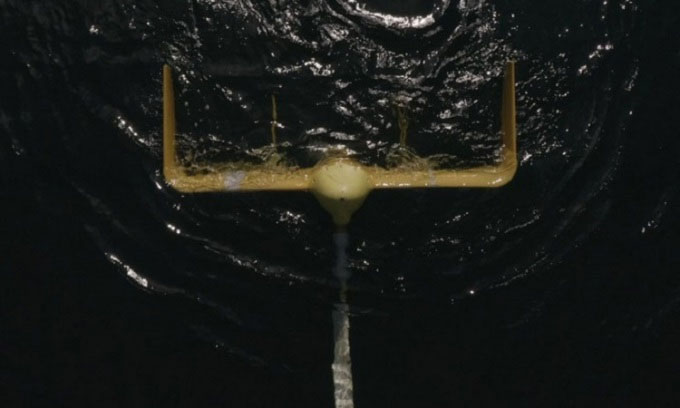Airplane-like turbine design produces electricity from ocean currents
The new bladed turbine design will help the Faroe Islands generate all of its electricity from renewable sources by 2030.
The Swedish engineering company Minesto has developed a series of tidal turbines nicknamed "sea dragons" with the shape of a submerged aircraft. Minesto is operating two winged turbines in the waters of the Faroe Islands in the northern Atlantic Ocean. These turbines produce electricity from ocean currents.

Turbine "sea dragon" swims with currents.
The tidal turbine is anchored to the seabed by a metal cable 40 meters long. With a wingspan of 5m, each turbine can hover underwater in configuration number 8, producing enough electricity to power 4-5 households.
The principle of operation of the turbine is very similar to the wind turbine developed by Kitekraft. Minesto's winged turbine generates momentum and electricity through lift from the water currents. Meanwhile, Kitekraft's design has the advantage of being recovered during strong storms or high winds to prevent damage. Both companies' systems are deployed in clusters, with each machine anchored far apart to avoid collisions.
Minesto's tidal turbines use a built-in computer to move towards the prevailing ocean current, for as much efficiency as possible. Electricity was transmitted via a cable connected to another undersea cable that connected to a control station near the coastal town of Vestmanna.
Two turbines in use from Minesto contributed to the power of the Faroe Islands during last year's test. Currently, the company is developing a turbine model with a wingspan of 12m, which can produce 1.2 megawatts of electricity. A cluster of underwater turbines is enough to power half of the households on the Faroe Islands (25,000 households). The project will help the archipelago achieve its goal of generating all its electricity from renewable energy sources by 2030.
- Japan tests electricity production by ocean currents
- Successfully built turbine-free turbine
- Design a wind turbine that flies automatically like a kite
- Wind turbine balloons
- Unprecedented ocean currents were discovered by ... seals
- Ultra-small wind turbine for smartphones
- Turbine giant Selsam
- Video: Ocean flow in the world
- The cause of wind, tide and sea currents
- The world's largest turbine generator
- New design for airplane seats
- 'Doomsday' comes true: the ocean is paralyzed, bringing the Earth back to the Ice Age?
 The US company is about to build a supersonic passenger plane of 6,000km / h
The US company is about to build a supersonic passenger plane of 6,000km / h Japan develops avatar robot as in fiction film
Japan develops avatar robot as in fiction film Australia tested the world's first mango picking robot
Australia tested the world's first mango picking robot America develops technology to separate water from animal waste
America develops technology to separate water from animal waste Vortex turbine can produce electricity continuously 24/7
Vortex turbine can produce electricity continuously 24/7  World's largest onshore wind turbine in China
World's largest onshore wind turbine in China  Development of a 40 MW . dual-wing floating wind turbine model
Development of a 40 MW . dual-wing floating wind turbine model  The cemetery contains 4,000 giant wind turbine blades in the US
The cemetery contains 4,000 giant wind turbine blades in the US  Produce Asia's largest hurricane-resistant wind turbine
Produce Asia's largest hurricane-resistant wind turbine  Superconducting tape can help create wind power at a lower cost
Superconducting tape can help create wind power at a lower cost 